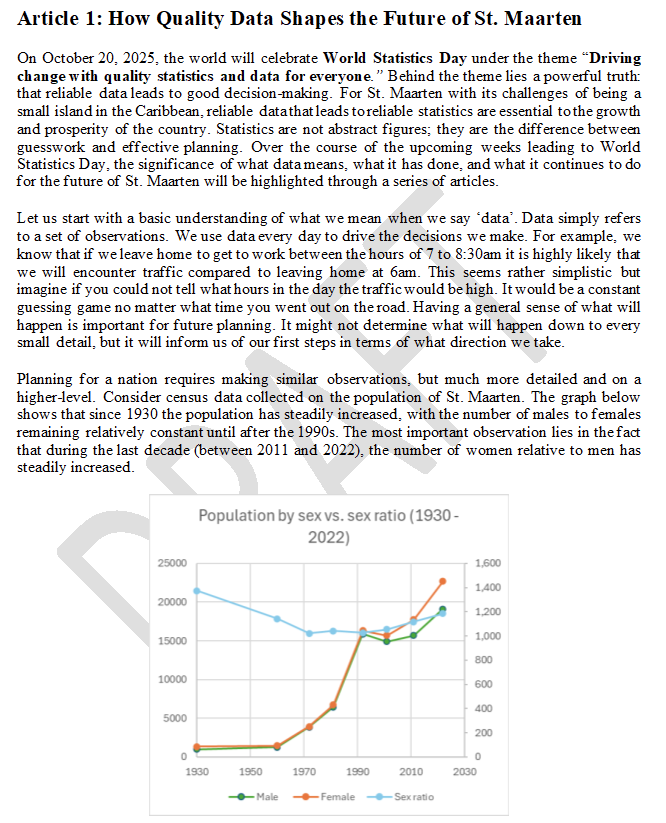World Statistics Day October 20 2025
Article 1: How Quality Data Shapes the Future of St. Maarten
On October 20, 2025, the world will celebrate World Statistics Day under the theme “Driving change with quality statistics and data for everyone." Behind the theme lies a powerful truth: that reliable data leads to good decision-making. For St. Maarten with its challenges of being a small island in the Caribbean, reliable data that leads to reliable statistics are essential to the growth and prosperity of the country. Statistics are not abstract figures; they are the difference between guesswork and effective planning. Over the course of the upcoming weeks leading to World Statistics Day, the significance of what data means, what it has done, and what it continues to do for the future of St. Maarten will be highlighted through a series of articles.
Let us start with a basic understanding of what we mean when we say 'data'. Data simply refers to a set of observations. We use data every day to drive the decisions we make. For example, we know that if we leave home to get to work between the hours of 7 to 8:30am it is highly likely that we will encounter traffic compared to leaving home at 6am. This seems rather simplistic but imagine if you could not tell what hours in the day the traffic would be high. It would be a constant guessing game no matter what time you went out on the road. Having a general sense of what will happen is important for future planning. It might not determine what will happen down to every small detail, but it will inform us of our first steps in terms of what direction we take.
Planning for a nation requires making similar observations, but much more detailed and on a higher-level. Consider census data collected on the population of St. Maarten. The graph below shows that since 1930 the population has steadily increased, with the number of males to females remaining relatively constant until after the 1990s. The most important observation lies in the fact that during the last decade (between 2011 and 2022), the number of women relative to men has steadily increased.

The female population is growing faster than the male population. What does this mean for St. Maarten now and what does it mean for the future? If the trend continues, more females in the population could reshape the composition of the workforce, impact the demand on health and social services, and influence education policy planning. For example, a growing number of women in the workforce could drive the need for more flexible work arrangements, greater investment in maternal health and childcare facilities, and expanded opportunities for women in leadership and technical professions. It also signals the importance of ensuring boys and young men are not left behind in education and employment opportunities, maintaining balance and equity in development. Further caution is also necessary as a much more targeted development approach would require further analysis, such as examining if the women were mostly of childbearing age or if they were elderly.
Nonetheless, it is evident that quality data is the foundation of sound planning. St. Maarten's shifting demographics highlight just one example of how statistics reveal important trends that will shape the nation's future. Whether it is preparing for changes in the labour force, strengthening healthcare systems, or crafting education policies, data arms policymakers with the insights needed to act decisively. As we approach World Statistics Day 2025, let us recognize that investing in data collection, analysis, and dissemination is not optional – it is mandatory! The future of St. Maarten depends on decisions rooted in evidence, not guesswork.










